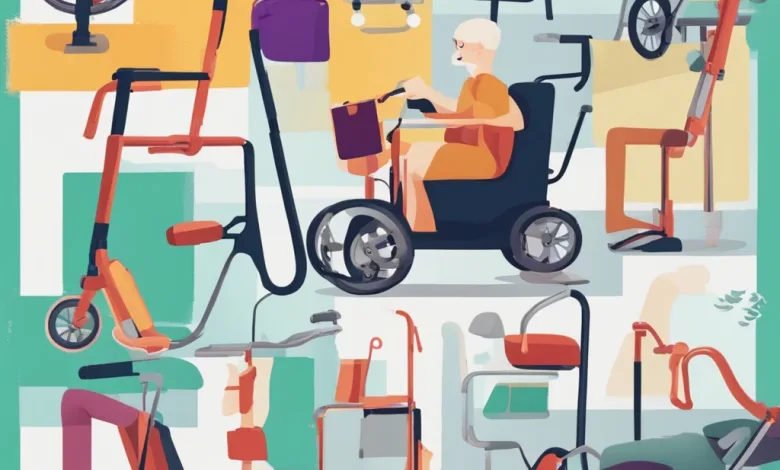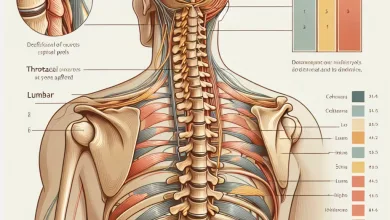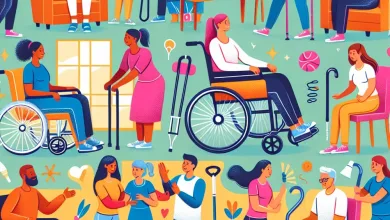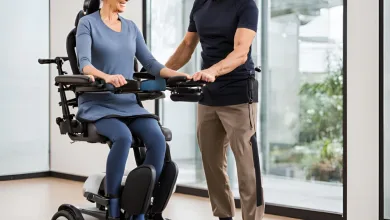Conquering Challenges: Your Guide to Mobility Aids

Table of Contents
Navigating the Path to Freedom: A Comprehensive Guide to Mobility Aids
As we age or encounter physical limitations, maintaining our independence and ability to get around can become more challenging. Thankfully, a vast array of mobility aids exists to empower individuals to regain their freedom and enhance their quality of life. This blog post delves into mobility aids, exploring their different types and advantages and valuable pointers on selecting the perfect one for your specific needs.
Types of Mobility Aids
There’s a mobility aid suited to every individual’s needs. Here’s a breakdown of some standard options:
- Zimmer Frames (Walkers):
Zimmer frames, also known as walkers, are typically crafted from lightweight metal and designed to provide stability and support for those with walking difficulties. They feature rubber grips on the handles for enhanced comfort and stability and rubber tips on the legs to prevent slipping. Walkers are particularly beneficial for those recovering from surgery or struggling with balance.
Pros and Cons of Zimmer Frames:
| Pros | Cons |
| Provides excellent stability | Can be cumbersome to use |
| Lightweight and easy to maneuver | Limited to walking assistance |
| Suitable for indoor and outdoor use | Requires some upper body strength |
Mobility Scooters:
Mobility scooters provide a contemporary and user-friendly option for individuals who struggle with walking extended distances. These scooters come with comfortable seating and steering handlebars and often feature a basket for personal items, making them perfect for outdoor use. By using a mobility scooter, individuals can significantly enhance their ability to engage in daily activities and socialize more effectively.
Pros and Cons of Mobility Scooters:
| Pros | Cons |
| Great for long distances | Expensive |
| Comfortable and easy to use | Requires storage space |
| Enhances outdoor mobility | Limited maneuverability in tight spaces |
Canes:
One of the most versatile and widely used mobility aids, canes provide extra support and balance for individuals who may only require minimal assistance. They come in various designs, including single-point canes, quad canes (featuring four prongs at the base for added stability), and folding canes for convenient storage. Canes are perfect for those who experience occasional instability or minor balance issues.
Pros and Cons of Canes:
| Pros | Cons |
| Lightweight and easy to carry | Provides limited support |
| Affordable | Not suitable for severe mobility issues |
| Versatile and available in many designs | Requires good hand strength |
Crutches:
Crutches are typically used for short-term mobility assistance, often following an injury or surgery. They help to alleviate weight from an injured leg or foot, allowing for proper healing. Crutches come in different varieties, such as underarm crutches and forearm crutches, each offering varying levels of support and comfort.
Pros and Cons of Crutches:
| Pros | Cons |
| Effective for short-term injuries | Can be uncomfortable with prolonged use |
| Adjustable height | Requires good upper body strength |
Rollators:
Rollators resemble Zimmer frames but boast additional features like wheels, a seat, and hand brakes. These aids are excellent for individuals who require more support than a cane can provide but still desire greater mobility. The seat provides users with the opportunity to rest whenever necessary, making rollators perfect for extended excursions.
Pros and Cons of Rollators :
| Pros | Cons |
| Enhanced Mobility: Provides better support for balance issues. | Size and Weight: Can be bulky and heavy. |
| Built-in Seat: Allows users to rest anytime. | Cost: More expensive than standard walkers or canes. |
| Storage Options: Offers convenient storage for belongings. | Maintenance: Requires regular upkeep for brakes and wheels. |
Benefits of Mobility Aids
Mobility aids offer a multitude of benefits, significantly impacting the lives of users:
- Enhanced Independence: Mobility aids empower individuals to move around more freely and independently, reducing their reliance on others for assistance.
- Improved Safety: Mobility aids can significantly reduce the risk of falls and injuries by providing additional support and stability, promoting a safer living environment.
- Increased Confidence: Using a mobility aid can boost confidence, allowing individuals to participate in social activities and maintain an active lifestyle. This can lead to a more fulfilling and enriching life.
- Pain Reduction: Mobility aids can alleviate pain by reducing strain on joints and muscles, especially for those with chronic conditions like arthritis. This can improve overall comfort and well-being.
Choosing the Right Mobility Aid
Selecting the most suitable mobility aid hinges on several factors, including your needs, physical condition, and lifestyle. Here are some tips to guide you in making an informed decision:
- Assess Your Needs: Consider the level of support you require. For minor balance issues, a cane may suffice, while more significant mobility challenges may necessitate a walker or mobility scooter.
- Consult a Healthcare Professional: A doctor or physical therapist can offer tailored advice based on your health status and medical history. They will assess your requirements and recommend the most appropriate mobility aid.
- Try Before You Buy: Whenever possible, test different mobility aids to see which one feels most comfortable and supportive for you. This allows you to experience firsthand how each aid functions and choose the one that best suits your physical capabilities.
Consider Your Environment: Consider where you will be using the mobility aid most frequently. A mobility scooter or rollator might be more suitable for outdoor use, while a cane or walker may be better for indoor maneuvering. Opt for an aid that allows you to navigate your environment safely and comfortably.
Budget: Mobility aids are available at a range of prices. Determine your budget and explore options that offer the best value for your money. Financial assistance programs might be available, so inquire with your healthcare provider or local organizations.
Making the Most of Your Mobility Aid
Once you’ve chosen your mobility aid, here are some pointers to ensure you get the most out of it:
- Proper Fitting: An adequately fitted mobility aid is essential for optimal safety and comfort. A physical therapist can help you ensure your aid is adjusted correctly for your height and physique.
- Practice Makes Perfect: Take some time to practice using your mobility aid in a safe, controlled environment. This will help you build confidence and become comfortable maneuvering your aid.
- Safety First: When using your mobility aid outdoors, prioritize safety. Be aware of your surroundings, avoid uneven terrain, and use caution in crowded areas.
Living a Fulfilling Life with Mobility Aids
Mobility aids are powerful tools that empower individuals to stay independent and live life to the fullest. They can be the key to unlocking a world of activity and participation, enriching your quality of life. By choosing the right aid and using it properly, you can continue participating in the activities you enjoy and live a fulfilling life.
Frequently Asked Questions (FAQs) About Mobility Aids
1. What are the different types of mobility aids available?
Mobility aids include Zimmer frames (walkers), scooters, canes, crutches, and rollators. Each type serves different needs and preferences based on the user’s physical condition and lifestyle.
2. How do I choose the right mobility aid for my needs?
Choosing the appropriate mobility aid requires considering various factorssuch as your mobility level, the environment where you’ll use the aid, personal preferences, and advice from healthcare professionals. Consulting with an occupational therapist can also be helpful.
3. What are the benefits of using a mobility aid?
Mobility aids can enhance independence, improve safety, reduce the risk of falls, and increase the ability to participate in daily activities and social outings. They also help relieve pain and fatigue associated with movement.
4. Can using a mobility aid improve mental health?
Yes, using a mobility aid can positively impact mental health by promoting independence, reducing anxiety about falling, and providing more opportunities for social interaction and physical activity.
5. How do I maintain my mobility aid?
Regular maintenance of mobility aids includes:
- Checking for wear and tear.
- Ensuring that all parts are clean and functioning correctly.
- Following the manufacturer’s care guidelines.
It’s important to regularly charge the battery and check the tires for mobility scooters.
6. Are there mobility aids specifically designed for children?
Yes, there are mobility aids specially designed for children, catering to their smaller size and specific needs. These aids often have adjustable features to accommodate growth and ensure comfort and safety.
7. What is the difference between a Zimmer frame and a rollator?
A Zimmer frame, or walker, is a basic frame that supports walking. A rollator is similar but has additional features like wheels, a seat, and hand brakes, making it more versatile for outdoor use and longer distances.
8. How can I get financial assistance to purchase mobility aid?
Financial assistance for mobility aids can come from various sources, including insurance, government grants, non-profit organizations, and charitable trusts. It’s advisable to check with local health services or a social worker for information on available funding options.
9. Are mobility scooters suitable for indoor use?
While mobility scooters are primarily designed for outdoor use, some models are compact and maneuverable enough for indoor settings. Choosing a scooter that fits the space and meets your needs is essential.
10. What should I consider when traveling with a mobility aid?
When traveling with a mobility aid, consider portability, ease of transport, and any special assistance you may need at airports or other transit points. Make sure to plan and check the regulations for mobility aids with your transportation provider.
By exploring the mobility aids available, from trusty canes to whizzy scooters, you’re well on your way to making an informed decision. Remember, these tools boost your independence, safety, and confidence. When choosing the perfect fit, consider your daily routines, any medical needs you have, and of course, your lifestyle.
Remember—regular maintenance keeps your mobility aid running smoothly. To top it all off, a chat with your doctor or physical therapist can unlock personalized advice tailored just for you. So, take that first step towards a more mobile you—with the right support and guidance, anything is possible!step towards a more mobile you—with the right support and guidance, anything is possible!



